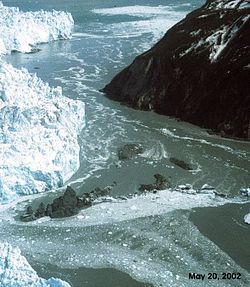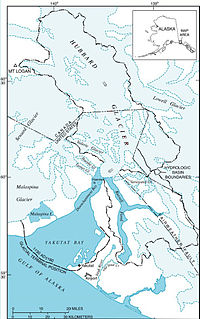
Hubbard Glacier
Did you know...
This selection is made for schools by a children's charity read more. SOS mothers each look after a a family of sponsored children.
| [[Image:|272px]] | |
| Type | Tidewater/Mountain glacier |
|---|---|
| Location | Alaska, U.S., Yukon, Canada |
| Coordinates | 60°00′54″N 139°29′31″W |
| Length | 122 km (76 miles) |
| Terminus | Sealevel |
| Status | Stable/Advancing |
Hubbard Glacier is a tidewater glacier in the U.S. state of Alaska and the Yukon Territory of Canada. From its source in the Yukon, the glacier stretches 122 km (76 mi) to the sea at Yakutat Bay and Disenchantment Bay. It is the longest tidewater glacier in Alaska, with an open calving face over ten kilometers (6 mi) wide.
Details

Hubbard Glacier’s longest source, 122 km from its snout, is at about 11,000 feet above sea level at about 61-00N 140-09 W, about eight kilometers west of Mt. Walsh. A shorter tributary glacier begins at the easternmost summit on the Mt. Logan ridge at about 18,300 feet at about 60-35 N 140-22-40 W.
Before it reaches the sea, Hubbard is joined by the Valerie Glacier to the west, which, through forward surges of its own ice, has contributed to the advance of the ice flow that experts believe will eventually dam the Russell Fiord from Disenchantment Bay waters.
The Hubbard Glacier ice margin has continued to advance for about a century. In May 1986, the Hubbard Glacier surged forward, blocking the outlet of Russell Fiord and creating "Russell Lake." All that summer the new lake filled with runoff; its water level rose 25 meters, and the decrease in salinity threatened its sea life.
Around midnight on October 8 the dam began to give way. In the next 24 hours an estimated 5.3 km³ of water gushed through the gap, and the fiord was reconnected to the ocean at its previous level. This was the second largest glacial lake outburst flood (GLOF) in recorded history.
In spring 2002, the glacier again approached Gilbert Point. It pushed a terminal moraine ahead of its face and closed the opening again in July. On August 14, the terminal moraine was washed away after rains had raised the water level behind the dam it formed to 18 m (61 ft) above sea level. The fiord could become dammed again, and perhaps permanently. If this happens, the fiord could overflow its southern banks and drain through the Situk River instead, threatening trout habitat and a local airport.
The ice at the foot of Hubbard Glacier is about 400 years old: it takes that long for ice to traverse the length of the glacier. The glacier routinely calves off icebergs the size of a ten-story building. Where the glacier meets the shore, most of the ice is below the waterline, and newly calved icebergs can shoot up quite dramatically, so that ships must keep their distance from it as they ply their way up and down the coast.


